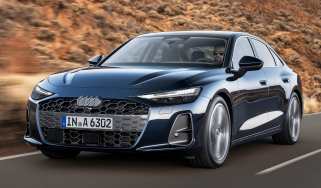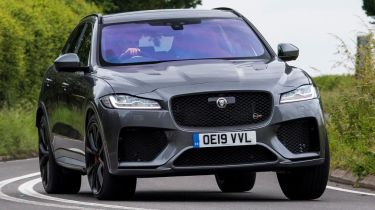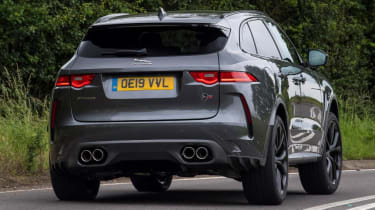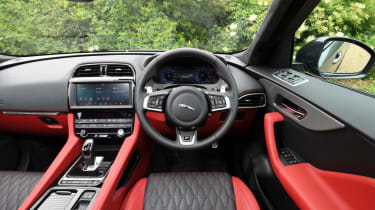Jaguar F-Pace SVR review
The Jaguar F-Pace SVR is a supercar-matching SUV but you'll have to tolerate big fuel bills
The Jaguar F-Pace SVR is the car the firm said it would never build. Bolting the 5.0-litre supercharged V8 used in the F-Type coupe and luxurious XJ saloon into an SUV once seemed like lunacy but with fast SUVs from BMW, Alfa Romeo and Mercedes all proving popular with buyers, Jaguar decided it was time to muscle in.
The task of cramming the engine in, and making the rest of the car capable of handling the extra power, was given to JLR’s talented Special Vehicle Operations (SVO) department. Under the louvred bonnet, which is unique to the SVR, lies the V8 petrol engine paired with an eight-speed automatic gearbox developed especially for this car.
• Best-looking cars you can buy
Unlike the Jaguar F-Type SVR and the Range Rover Sport SVR, which share the same engine, the F-Pace has been dialled back slightly from 567bhp to 542bhp. That’s still plenty for a car like this and around 40bhp more than the Alfa Romeo Stelvio Quadrifoglio, Mercedes-AMG GLC 63 S and BMW X3 M Competition. However, the Jaguar is heavier than all of these rivals so is actually the slowest from 0-62mph, although at 4.3 seconds it is still plenty fast enough to worry some supercars.
That 5.0-litre V8 is central to the SVR’s character and probably its most attractive feature to most buyers – especially as most rivals now have turbocharged six-cylinders and can’t deliver the same intoxicating noise as the SVR’s substantial V8 engine. Accelerate hard and the pace is explosive, flattered with a quick-shifting gearbox with specially chosen ratios. But if that’s not exciting enough, there’s the unmistakable whine from the supercharger as well.
The downside to this, of course, is at the pumps with the F-Type SVR managing around 20mpg at best.
Other than the engine, styling changes include quad chromed exhaust pipes, an additional lip on the rear spoiler and sportier body styling consisting of new front and rear bumpers and sills finished in satin grey. It gives the SVR a more purposeful look than the lower models in the range, and Jaguar says they are not just for show, as they improve the aerodynamics too.
But while the SVR looks purposeful, it has far more subtle styling when compared to some rivals. Even with the optional 22-inch wheels (21-inch wheels are standard) the SVR’s look is surprisingly understated.
Meanwhile, on the inside, there are slim bucket seats in a choice of colours and trimmed with a ‘lozenge’ shape quilting, which is supposedly a nod to the original Jaguar logo. There’s also a shorter gear selector and a special SVR steering wheel with aluminium gearshift paddles for manual gear changes. It feels suitably plush for a near £80,000 car but the infotainment system, which controls the navigation, phone and sound system, remains a weak point as it's fiddly to use.
Jaguar’s SVO department has also made substantial modifications to the brakes (with bigger 395mm discs front and rear), chassis and steering, along with uprated dampers and springs and a new electronic differential at the back. These all make the SVR more able to cope with the extra performance and less wallowy than the standard car in the corners.
With those changes in mind you’d expect there to be a sharp difference between the standard F-Pace and the SVR but, even with bigger wheels and the sportier low-profile tyres, the ride is surprisingly supple once up to speed. Even when ‘Dynamic’ is selected from the electronic drive modes, it’s never unbearable and the whole car is easy to drive. In this respect, the Jag feels more comfortable than some rivals, especially the highly-strung Alfa.
While SVO has worked on the handling, it’s not a hot SUV that trades its usability for outright performance. This is a car which can be used everyday and isn’t designed for ultimate lap times on a track. Turn into a corner and, while it is quicker to react than the standard car, there is some body roll and the Jag feels a much larger car to drive fast than the Mercedes GLC or the Alfa Romeo Stelvio.
And that’s where the Jaguar stands out compared to its arguably more aggressive competition – it's slightly softer, has an easier-to-live-with temperament but still delivers stunning performance.
Verdict 4/5
Jaguar’s range-topping, high-performance halo car blends near supercar performance and SUV practicality. It has the space and comfort of a big family car, but in a straight line will keep up with supercars. It’s not alone in the market, but the F-Pace SVR’s trump card against some formidable rivals is having a characterful, supercharged V8 where rivals have downgraded to smaller turbocharged six-cylinder engines.
Despite its performance, the Jaguar is quite restrained in the styling department and manages to retain some of the refinement you’d expect from the brand. The downside is that it’s a little softer in the corners than its more focused rivals, and the 20mpg fuel economy means you’ll be filling it up regularly.
Want to know more about Jaguar’s SUV range? Read our in-depth review of the F-Pace and the E-Pace.
Most Popular

The new Audi A6 saloon has finally landed, and costs from just over £50k

Omoda E5 targets rivals: now with zero deposit and APR
Tips & advice

Car dashboard warning lights: what does each symbol mean?

Electric car charging stations: public networks, charger types, apps and maps









